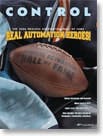CERTAINLY, none of this year’s inductees into the Process Automation Hall of Fame decided as children that they wanted to be Automation Heroes. Automation is a career that most people just fall into, as you will see in the careers of Dick Morley and Cy Rutledge. Nonetheless, these inductees’ career accomplishments rank them in the small number of people, whose contributions to process automation have made significant differences in the art and practice of the discipline.
We all need heroes, even automation engineers. Especially now, we need heroes in process automation that we can point children to when we talk about the benefits of careers in manufacturing and automation. Fewer and fewer children are interested in manufacturing as a career choice. Not all manufacturing is going to be off-shored, and we’ll need those young people in the years to come.
CONTROL is proud to present to you this year’s class of inductees into the Process Automation Hall of Fame. The induction will take place, once again, during the Hall of Fame dinner at the World Batch Forum (WBF) on March 5 at the Sheraton Gateway Hotel, near Atlanta’s Hartsfield-Jackson International Airport. You can get all the details at www.wbf.org. We invite all of CONTROL’s readers to attend, and to stay and attend WBF.
| Edgar H. Bristol II |
Currently, Bristol is striving to avoid retirement, and working as a consultant, both inside Foxboro and outside. With fellow Hall of Famer Ted Williams, of Purdue University, Ed had a leading role in creating the “Purdue Workshop for Industrial Computer Systems” from which many continuous and batch process control techniques have come. He is a well-known author, who has well over 100 papers, and a dozen patents to his name in control, adaptive control, multivariable control, control software and languages.
Like fellow inductee, Dick Morley, Bristol is a graduate of MIT. He is the originator of relative gain array (RGA) analysis (1965), which is the forerunner of today’s multivariable control. He also originated pattern-recognition-based adaptive control strategies that are used widely today, especially in machine vision applications.
Bristol is a tireless contributor to professional societies like ISA, IEEE, AIChE, ACM and others, and has been active in standards writing efforts for nearly 40 years. Among his other awards, appropriately, is the Dr. Guido Carlo-Stella Award, which he received from WBF in 2004, for his seminal effort in getting WBF started and his contribution to batch theory.
One of Bristol’s most important recent contributions to the field of process automation is the paper he delivered at ISA2002 entitled, “A Control Retrospective: What We Should Have Done.” The conclusion of the paper says, “Process Control is in a quandary. The digital systems, which should make life easier, continue to make it harder. And at a time when digital expertise is beginning to face up to the consequences of digital complexity (sic).”
Bristol goes on to say, “A restoration of the traditional user/vendor division of labor would act to restore a real progress to the field.” Whether he is right or not, Bristol’s exemplary contribution to the field of process automation goes on.
Bristol Ed is married to Julie, has three daughters, and enjoys playing with rhododendrons, orchids and bicycles, when he isn’t doing process automation.
| Richard E. Morley |
In 1960, he patented magnetic thin film. His invention made possible high capacity data storage, first on floppy disks, and then on tiny hard drives, even like those found today in iPods. In 1968, he founded Modicon, and (along with the late Otto Struger, of Allen-Bradley) is considered the “Father of the PLC.” In 1970, he patented a handheld terminal (Termiflex) that is the ancestor of field calibrators, programmers and the PDA. Finally, in 1976, he founded Andover Controls, and created the first modern building automation system.
While all these patents are used in many industries, they have all had a substantial impact on process automation. As the PLC matured from a “relay replacement” to a complete, hybrid controller, the modern distributed control system in process automation looks an awful lot like a PLC with an HMI at the other end of a network. Nearly every instrument vendor provides a handheld programmer that is a direct descendant of the Termiflex terminal.
Since then, Morely has had a hand in founding more than a dozen companies, and serves as a very popular high technology consultant to business and government. Recently, he made a new career as a manufacturing futurist, and serves as board chairman for the National Center for Manufacturing Sciences (NCMS).
Morely also is a subscriber to the “give back and pay forward” school of life. He and his wife Shirley have had over 30 foster children during their 46 years of marriage, and he is a major driver in an angel investment group that targets young entrepreneurs for help.
While it is not true that Morely quit his real job to become a consultant because his employer insisted that he wear a suit and tie to work, it is true that he quit because his employer wouldn’t allow him flextime, so he could ski during the week and avoid the lift lines. Morely is a Harley-Davidson rider from way back, riding almost immediately after knee surgery, and he has a marvelously customized John Deere tractor, which he can drive over the Web.
| Wyman "Cy" Rutledge |
During that time, his contributions to controlling the process of papermaking were enormous. Rutledge also taught math and physics at several universities in Ohio and New York, while continuing his career at Mead.
“We were familiar with the control work done by IBM and a steel company in Cleveland, and thought this could be applied to paper processes,” says Rutledge. “It was used for applying color, coatings, fillers and other additives in the papermaking process. Also it was extended to controlling the basis weight by means of a variable stock flow valve at the headbox.”
The information was fed back to controllers and the lab from a basis weight measurement at the reel. This information was used for studies, not just for feedback or feedforward control. According to Rutledge, this enabled Mead to move ahead of its competitors by supplying higher-quality paper to companies like Hallmark.
Rutledge then participated in installing one of the first computer-controlled paper machines, and the first one at Mead.
Over the years, until his retirement in 1990, Rutledge became one of the most effective theorists of process control as applied to papermaking, and his contributions to professional standards bodies are considerable. He contributed both to continuous process management and to batch process management, especially in the addition of and creation of additives. He was one of the principal founders and supporters of Miami University of Ohio’s Pulp and Paper Symposium, and received an honorary doctorate from the university.
Rutledge graduated from Hiram College in Hiram, Ohio, served in the U.S. Army during World War II, and earned both a M.S. and Ph.D. in nuclear physics from the University of Michigan at Ann Arbor. He is, therefore, another lifetime process automation professional, who initially set out to do something entirely different—a typical occurrence in the field.
Rutledge continues to live in Chillicothe with his wife Mary, but his increasingly poor health in recent years has prevented him from coming to WBF to receive his award in person.
| Kathleen Waters |
Waters has been responsible for many strategically important assignments in her career, including process systems software development, process information management systems, manufacturing execution systems, automation architecture and quality initiatives for systems supporting process development and cGMP operations. Note that her career starts where the groundbreaking developments of the first generation of automation heroes leave off.
Waters established a scalable automation architecture, enabling process and implementation standardization. She was an early adopter of plant-floor Ethernet, automation network segregation, and web-based data access. Her work relies heavily on industrial standards and benchmarking to establish models for implementation. She has worked repeatedly on compliance programs, collaboration and driving best practices.
Waters also led development of the S88.04 Batch Production Record standard, a reference model for batch production records, containing information about production of batches or other elements of production, and she currently is the ISA S88 committee’s vice chair, as well as a member of WBF.
In addition, Waters’ experience with batch processes gave her the ability to make S88.04 a true cross-industry standard, which has been adopted, not only by batch processing companies, but also by automation vendors, MES and ERP departments, and even by vendors like Microsoft, IBM and SAP. Her infectious energy, enthusiasm and sense of humor have made it possible for her to lead teams of disparate constituents to common goals and solutions. She listens well, which allows her to tread the minefields of modern standards efforts, and produce timely and relevant solutions to major process automation problems.
Waters loves to golf, ski, and like other Hall of Fame members, to garden. Oh, yes, one final thing about Waters. We’re pleased to note that she is the first woman to be inducted to the Process Automation Hall of Fame.

Leaders relevant to this article:








